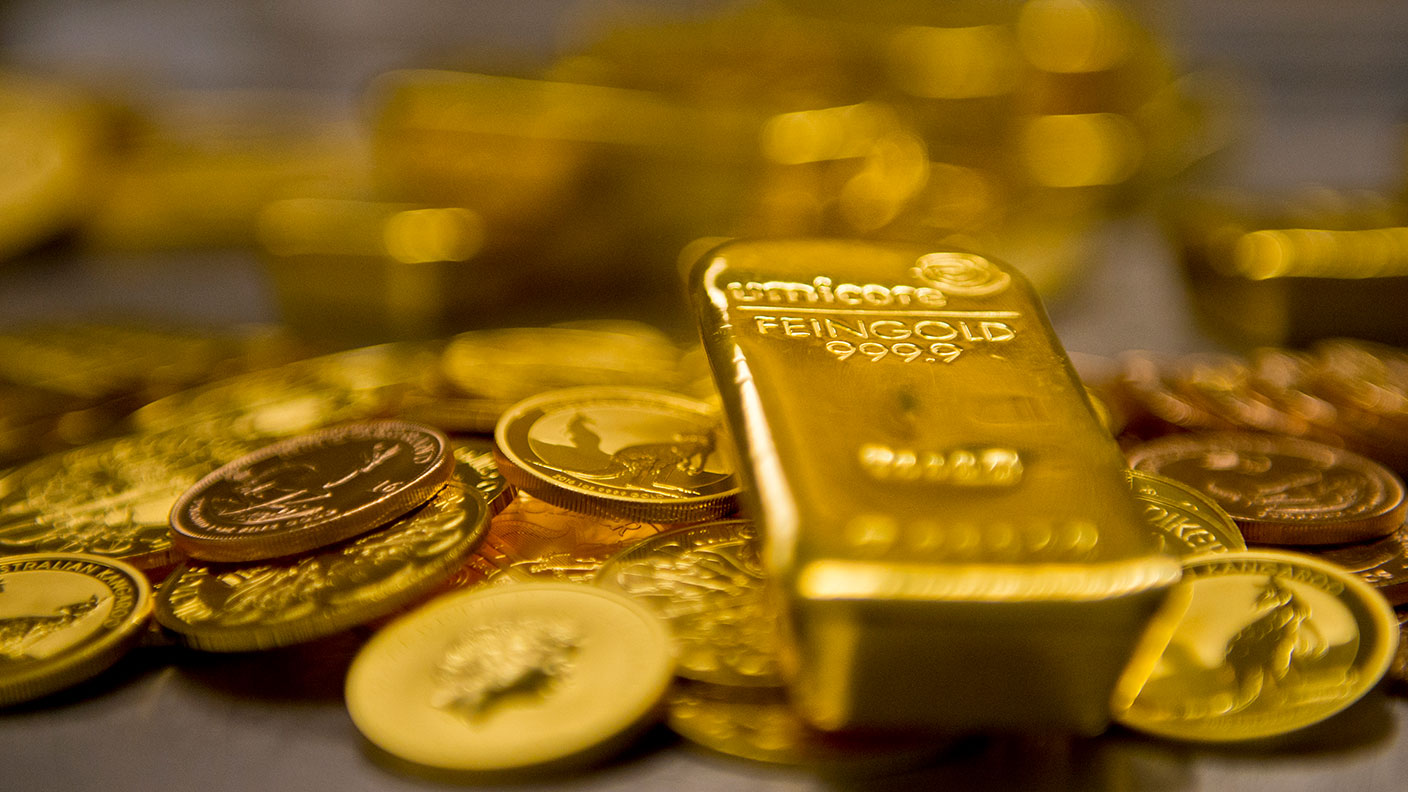Gold: a metal with magical powers
Gold is indestructible and has outlasted all other forms of money, says Dominic Frisby


I am going to the Edinburgh Fringe this August to do one of my comedy lectures. This one is about gold: its history, its fascination, its future. It really is the most amazing metal, not least because it is, as Spandau Ballet famously sung, indestructible. Life may be temporary, but gold is permanent.
No other substance is as durable – not diamonds, not tungsten carbide, not boron nitride. You can shape this enormously ductile metal into virtually anything. An ounce of gold can be stretched into a wire 50 miles long. You can beat it into a leaf just one atom thick. Yet there is one thing you cannot do, and that is destroy it.
You can change its form by dissolving it in certain chemical solutions or alloying it with other metals. You can even vaporise it. But the gold will always be there. It is theoretically possible to destroy gold through extreme methods such as nuclear reactions, but in practical terms, gold is indestructible. That makes it unique among natural substances: the closest thing we have on Earth to immortality.
MoneyWeek
Subscribe to MoneyWeek today and get your first six magazine issues absolutely FREE

Sign up to Money Morning
Don't miss the latest investment and personal finances news, market analysis, plus money-saving tips with our free twice-daily newsletter
Don't miss the latest investment and personal finances news, market analysis, plus money-saving tips with our free twice-daily newsletter
Perhaps that is why practically every ancient culture we know of associated gold with the gods and why the Egyptians believed it had magical powers that gave you safe passage into the afterlife.
In a museum in Cairo you will find a golden tooth bridge made for a well-to-do Egyptian 4,500 years ago. It is good enough to go in someone’s mouth today, (though I would give it a good scrub first). In 2021 a metal detectorist by the name of Ole Ginnerup Schytz unearthed a Viking gold hoard in a field near Jelling in Denmark. The gold was just as it was when it was buried 1,500 years earlier, if a little dirtier. Gold does not corrode, it does not tarnish, it does not break down over time.
All the gold in the world
All the gold ever mined worldwide still exists in one form or another. Some may have been lost, but none of it has been destroyed. What’s more, it will always exist. Even tiny specks of gold dust are permanent.
Park that thought for a moment, as we consider how gold came into existence. No one really knows the answer to that. Divine creation is one widely held theory. Another is that gold’s origins lie in supernovae and the collision of neutron stars.
Scientists think they actually witnessed gold being created in August 2017. Some 130 million light-years away, two neutron stars, each as small as a city but heavier than the sun, collided. The collision caused a colossal convulsion known as a kilonova.
An enormous amount of energy was then released in the form of gravitational waves and electromagnetic radiation, including visible light, which was observed by telescopes around the world as it rippled through space and time to Earth.
Astronomers were able to measure the amount of heavy elements produced by the collision because of the multiple wavelengths and bright optical and infrared glow. Something like 16,000 Earth masses of material was hurtled into space, says Harvard astronomer Edo Berger, creating “ten times the Earth’s mass in gold and platinum alone”. (Gold makes up about one-millionth of the Earth’s mass, and most of that is still in the planet’s core.)
“It makes it quite clear that a significant fraction, maybe half, maybe more, of the heavy elements in the universe are actually produced by this kind of collision,” said physicist Patrick Sutton of the Laser Interferometer Gravitational-Wave Observatory in the US.
High temperature and high pressure in the cores of neutron stars, argue scientists, cause atomic nuclei to capture free neutrons in a process known as “neutron capture”. The resulting nuclear reactions then lead to the formation of gold.
When these neutron stars eventually die, they explode as supernovae and disperse the gold and other elements that were created into space.
Perhaps the Incas and Aztecs were not so wrong to see gold as the tears of the sun. Our solar system was formed from the cloud of gas and dust (a so-called solar nebula) that resulted from one such stellar collision.
Small, solid objects – planetesimals – are then formed by accretion: the process of gravitational attraction by which small particles in space stick together. These planetesimals grew and grew, through continued accretion and collision, to form the planets.
In short, gold was present in the dust that formed the solar system four-and-a-half billion years ago. Being permanent, it is exactly the same today as it was then. Isn’t that an amazing thought? That little bit of gold you may be wearing on your person is older than the Earth itself. In fact, it is older than the solar system, as old as stardust. To touch gold is as close as you might ever come to touching eternity.
A display of wealth
Yet this eternal substance is as good as useless. Unlike other metals, which we use to build things, cut things or conduct things, gold’s industrial use is so limited as to be non-existent. It is a good conductor of electricity, but copper and silver are better and cheaper. It has some use in dentistry and in medical applications, such as radiation therapy and the treatment of arthritis, but such uses are minimal in the greater context.
Gold’s purpose is as a store or display of wealth.
It has no other significant use. It is dense, tangible value: pure money. Over the years we have used all sorts of different things as money: shells, pieces of specially printed paper, computer bits, and promises.
But one has outlasted them all, and that is gold.
This article was first published in MoneyWeek's magazine. Enjoy exclusive early access to news, opinion and analysis from our team of financial experts with a MoneyWeek subscription.
Get the latest financial news, insights and expert analysis from our award-winning MoneyWeek team, to help you understand what really matters when it comes to your finances.
Dominic Frisby (“mercurially witty” – the Spectator) is as far as we know the world’s only financial writer and comedian. He is the author of the popular newsletter the Flying Frisby and is MoneyWeek’s main commentator on gold, commodities, currencies and cryptocurrencies. He has also taken several of his shows to the Edinburgh Festival Fringe.
His books are Daylight Robbery - How Tax Changed our Past and Will Shape our Future; Bitcoin: the Future of Money? and Life After the State - Why We Don't Need Government.
Dominic was educated at St Paul's School, Manchester University and the Webber-Douglas Academy Of Dramatic Art.
You can follow him on X @dominicfrisby
-
 ‘Why I have ditched my Help to Buy ISA for cash savings and the stock market’
‘Why I have ditched my Help to Buy ISA for cash savings and the stock market’Without the 25% bonus, my Help to Buy ISA is effectively redundant, says MoneyWeek writer Sam Walker.
-
 Is your inheritance tax allowance cut if you sell to downsize or sell your home to pay for care?
Is your inheritance tax allowance cut if you sell to downsize or sell your home to pay for care?Downsizing relief is a little-known benefit that could save your loved ones tens of thousands of pounds in inheritance tax after you’ve died.
-
 Stock markets have a mountain to climb: opt for resilience, growth and value
Stock markets have a mountain to climb: opt for resilience, growth and valueOpinion Julian Wheeler, partner and US equity specialist, Shard Capital, highlights three US stocks where he would put his money
-
 The steady rise of stablecoins
The steady rise of stablecoinsInnovations in cryptocurrency have created stablecoins, a new form of money. Trump is an enthusiastic supporter, but its benefits are not yet clear
-
 SRT Marine Systems: A leader in marine technology
SRT Marine Systems: A leader in marine technologySRT Marine Systems is thriving and has a bulging order book, says Dr Michael Tubbs
-
 Goodwin: A superlative British manufacturer to buy now
Goodwin: A superlative British manufacturer to buy nowVeteran engineering group Goodwin has created a new profit engine. But following its tremendous run, can investors still afford the shares?
-
 A change in leadership: Is US stock market exceptionalism over?
A change in leadership: Is US stock market exceptionalism over?US stocks trailed the rest of the world in 2025. Is this a sign that a long-overdue shift is underway?
-
 A reckoning is coming for unnecessary investment trusts
A reckoning is coming for unnecessary investment trustsInvestment trusts that don’t use their structural advantages will find it increasingly hard to survive, says Rupert Hargreaves
-
 Metals and AI power emerging markets
Metals and AI power emerging marketsThis year’s big emerging market winners have tended to offer exposure to one of 2025’s two winning trends – AI-focused tech and the global metals rally
-
 8 of the best houses for sale with beautiful fireplaces
8 of the best houses for sale with beautiful fireplacesThe best houses for sale with beautiful fireplaces – from a 15th-century cottage in Kent to a 17th-century palazzo in Oxfordshire
